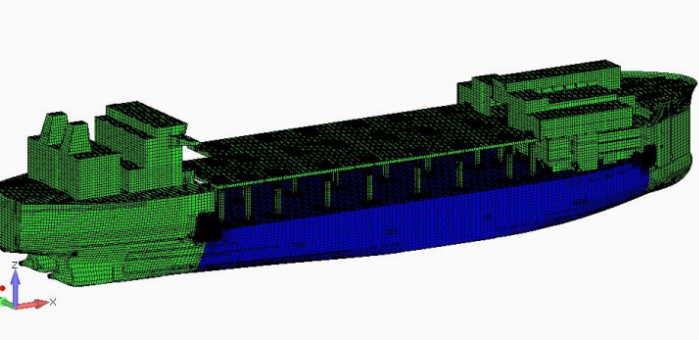The Ship Structure Committee published a new report, called: ‘Structural Assessment of Aged Ships’. The aims of this report is to develop an assessment process to accurately predict how possible is a corrosion-degraded ship to survive in specific wave conditions.
Namely, the report describes the development of an assessment process to accurately predict the survivability of a corrosion-degraded ship in specific wave conditions. The method uses a ship-specific 3-D hydrodynamic model to simulate the ship’s rigid body dynamic response to wave conditions, measuring the resulting ship motions and pressure distribution on the hull.
[smlsubform prepend=”GET THE SAFETY4SEA IN YOUR INBOX!” showname=false emailtxt=”” emailholder=”Enter your email address” showsubmit=true submittxt=”Submit” jsthanks=false thankyou=”Thank you for subscribing to our mailing list”]
Pressure and acceleration data from the hydrodynamic model is then put into a 3-D finite element model of the degraded ship structure where the resulting stresses in stiffeners and plating are assessed against various failure modes, including buckling modes, which are calculated according to IACS Common Structural Rules. The results form the basis of a degraded ship strength assessment which can be provided to a ship owner and operator to make operational and repair decisions.
This ultimately allows operators to understand the risk of, and help minimize the probability of structural failure when operational requirements, budgets or schedule do not permit the full remediation of the degradation. It may also be useful when assessing when a specific hull needs to be removed from service and scrapped.
After conducting a limited study of the Expeditionary Sea Base (ESB), a U.S. Navy Auxiliary ship, with uniform corrosion beyond the typical 25% limit, hull bottom plate buckling coefficients rise dramatically, so that even in the lower sea states buckling of the hull plating is possible.
A more thorough investigation may reveal other failure locations with less than 25% wastage. Future research on this topic could consider and evaluate the residual strength of a ship structure with localized corrosion damage. Localized and nonuniform structural corrosion and pitting are probably more common than uniform corrosion across the entire hull structure, but is very case-specific.
The approach that the report uses to assess a degraded ship structure can be expanded and used to develop a safe operating envelope for a ship’s hull structure with various degrees of corrosion. While many simplifications of scope and assumptions were made for this project, a more thorough assessment of a degraded ship structure can be accomplished, but would require modeling the ship’s actual corrosion levels, more seaway conditions, more headings and more ship loading conditions, amplifying loadings to account for expected exposure times, and investigating more structural components such as internal tank bulkheads and their internal fluid loadings.
In addition, green seas, whipping, and slamming effects may need to be addressed. This more rigorous assessment, while possible, would be a costly and time consuming effort, the report concludes.
See more details in the PDF below





























































